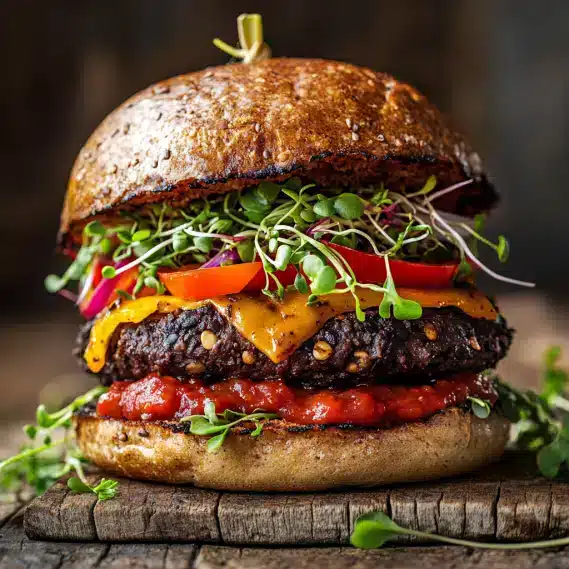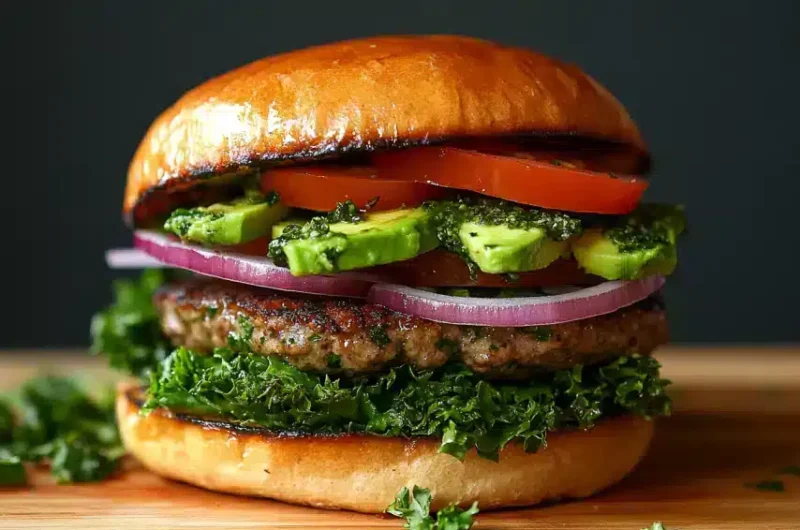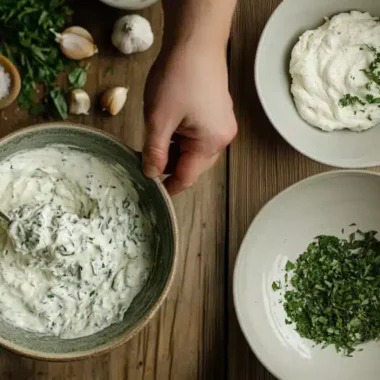Craving a burger but want to keep it healthy? It’s totally achievable! In this comprehensive guide, we’re diving into the world of healthy burgers. We’ll explore how to make better choices when it comes to lean ground meat, buns, toppings, and cooking methods. From choosing the right protein source to building a nutritious burger recipe that suits your preferences, we’ll guide you through everything you need to know about creating a guilt-free and delicious healthy burger. So, buckle up and get ready to transform your burger experience and enjoy a better-for-you burger!
What Makes a Burger Unhealthy?
Burgers, a classic comfort food, often get a bad rap for being unhealthy, and that’s usually because of a combination of factors. Therefore, understanding what makes a burger unhealthy is the first step in creating a healthy burger alternative. Many traditional burgers are loaded with things that can derail our wellness goals; let’s discuss what these culprits are. First and foremost, the most common issue with burgers is the high-fat content usually present in the ground meat. Often, these are made from beef with a higher fat percentage, which not only increases the calorie count but also contributes to unhealthy saturated fat intake. The type of fat matters, and consuming too much of saturated fat can lead to an increase in LDL cholesterol and heart disease.
Furthermore, the refined white buns that so often accompany them provide minimal nutritional value. They’re mostly made from processed flour, causing a quick spike in blood sugar levels and don’t provide much fiber, leaving you feeling hungry again soon after you’ve finished your homemade burger. In addition to the patty and bun, the healthy condiments choices also play a vital role. Many store-bought sauces and spreads can be packed with added sugars, unhealthy fats, and artificial additives. Things like high-fat cheese , while delicious can add unnecessary calories and saturated fat to your nutrient-rich meal. Finally, portion sizes can easily get out of hand. Many of us tend to underestimate how many calories we consume per burger.
Key Components of a Healthy Burger
Now that we’ve identified what makes a typical burger less than ideal, let’s explore the key components of a healthy burger. Creating a nutritious burger recipe is all about making smart choices with each element.
Firstly, let’s talk about the protein source. The type of meat you choose has a major impact on the overall healthiness of your burger. Lean ground meat options are your best bet here. Opt for leaner alternatives such as turkey or chicken, which are naturally lower in fat. Extra-lean beef is also a viable option, but be sure to check the percentage of fat on the label. However, if you’re looking to reduce or eliminate meat entirely, plant-based options are a fantastic choice. Consider using black bean burgers, which are packed with fiber and protein, or portobello mushroom burgers, which offer a meaty texture and are low in calories. Lentil burgers are another great source of plant-based protein and fiber too.
Each of these provides different nutritional benefits, therefore, experimenting with different alternatives can keep your meals interesting and ensure you’re getting a wide range of nutrients for the best burger for health. Furthermore, understanding portion sizes is also important to achieve a low-calorie burger. Aim for a moderate size, around 3 to 4 ounces of protein, to help with both portion control and calorie management. Moving on to the bun, it’s time to ditch the refined white buns and make more conscious choices for your homemade burger.
Whole-wheat buns are a much better alternative, because they are richer in fiber and nutrients and help stabilize blood sugar levels and provide a slow release of energy. The role of whole grain in your diet can not be overlooked as it is crucial for a balanced diet. A healthy burger alternative would be also lettuce wraps to reduce the carbs or you could use whole-grain buns.
Moreover, smart topping choices can take your burger from ordinary to extraordinary, while still keeping it healthy. Pile on the fresh vegetables like lettuce, tomatoes, onions, and peppers, which are naturally low in calories and high in vitamins and minerals and can definitely add a lot of flavor and texture to your delicious healthy burger. Avocado is also an excellent source of healthy fats in moderation, and it can be a great alternative for mayo. Nevertheless, when it comes to cheese, try to use low-fat options or plant-based cheeses, which can reduce the overall fat content.
Lastly, remember that healthy condiments choices are key. Consider homemade sauces instead of pre-made ones which can be high in sugar and additives. By focusing on these aspects, you can assemble a burger that is not only delicious but also genuinely good for you. So, with a bit of mindful planning and some clever ingredient swaps, you can make the healthiest burger without compromising on taste.
Cooking Methods for a Healthier Burger

The way you cook your burger is almost as important as the ingredients you use when trying to make the healthiest burger. The cooking method has a significant impact on the final fat content and overall nutritional value of your meal.
Therefore, choosing the right cooking technique can make a big difference in how healthy your burger truly is. Grilling, for example, is a fantastic option as it allows excess fat to drip away, reducing the overall fat content of the burger and creating a nice, slightly charred flavor. However, be mindful of high temperatures and potential charring which can produce harmful compounds. Baking is another excellent, healthy alternative. By baking your burger in the oven, you can control the temperature and avoid adding any extra fats or oils. Plus, it is a fuss-free method, perfect for busy weeknights. Furthermore, steaming or broiling your patties are other low-fat cooking methods. Steaming retains moisture, resulting in a tender patty, and broiling offers a crispy exterior. Pan-frying, on the other hand, while convenient, can sometimes be less healthy if you use a lot of oil.
If you opt for pan-frying, choose a healthy cooking oil and use it sparingly to achieve a low-calorie burger. Avoid using excessive amounts of butter, and be sure to use non-stick pans to avoid oil. It is important to note that a non-stick pan can be important to achieve a delicious healthy burger. The cooking method you choose significantly alters the final fat content, and by keeping that in mind you can make your homemade burger as healthy as possible. Therefore, choosing the right cooking method is essential for a healthier burger, it’s not just about what you put in your burger, but also how you cook it, impacting its overall health profile.
Recipes for the Healthiest Burger You Can Make
Now for the exciting part: putting all this knowledge into practice with some delicious and nutritious burger recipes. These recipes are designed to be both satisfying and good for you, highlighting smart swaps and ingredient modifications for a better-for-you burger. Remember, that these are guidelines, so don’t be afraid to adjust them based on your own preferences and dietary restrictions.
Recipe 1: The Ultimate Lean Turkey Burger
- Ingredients:
- 1 pound lean ground turkey
- 1/4 cup chopped onion
- 1 clove minced garlic
- 1/4 cup breadcrumbs ( whole grain recommended)
- 1 tablespoon fresh parsley
- 1 teaspoon dried oregano
- 1/2 teaspoon salt
- 1/4 teaspoon black pepper
- Whole wheat buns or lettuce wraps
- Healthy condiments choices, such as mustard, a little bit of low-fat mayo or hummus
- Toppings: lettuce, tomatoes, onions, avocado slices
- Instructions:
- In a large bowl, gently combine all the turkey burger ingredients with your hands.
- Form the mixture into 4 equal-sized patties.
- Grill or bake the patties until they are cooked through and reach an internal temperature of 165°F (74°C).
- Serve on whole-wheat buns or in lettuce wraps with your preferred toppings and condiments.
- Smart Swap: Instead of regular breadcrumbs, consider using whole-grain or almond flour for extra fiber and nutrients.
Second Recipe : The Amazing Black Bean Burger
- Ingredients:
- 1 (15-ounce) can black beans, drained and rinsed
- 1/2 cup cooked quinoa or brown rice
- 1/4 cup chopped onion
- 1/4 cup chopped bell pepper
- 1 clove minced garlic
- 1/4 cup rolled oats
- 1 tablespoon chili powder
- 1 teaspoon cumin
- 1/2 teaspoon salt
- 1/4 teaspoon black pepper
- Whole-grain buns or lettuce wraps
- Toppings: salsa, avocado, sprouts
- Instructions:
- Mash the black beans in a large bowl with a fork.
- Add the remaining ingredients to the bowl and mix well.
- Form the mixture into 4 equal-sized patties.
- Bake the patties at 375°F (190°C) for 20 minutes, flipping halfway through, or pan-fry them until golden brown.
- Serve on whole grain buns or lettuce wraps with toppings of your choice.
- Smart Swap: Add a dash of smoked paprika for an extra layer of flavor.
Recipe 3: The Perfect Portobello Mushroom Burger
- Ingredients:
- 2 large portobello mushroom caps, stems removed
- 2 tablespoons olive oil
- 1 clove minced garlic
- 1/2 teaspoon dried thyme
- 1/4 teaspoon salt
- 1/4 teaspoon black pepper
- Whole-wheat buns or lettuce wraps
- Toppings: arugula, roasted red peppers, balsamic glaze
- Low fat cheese is optional
- Instructions:
- Clean the portobello caps with a damp cloth.
- In a small bowl, combine olive oil, minced garlic, thyme, salt, and pepper.
- Brush the mushroom caps with the oil mixture.
- Grill or bake the mushroom caps for about 10-15 minutes or until tender.
- Serve on whole wheat buns or in lettuce wraps with your chosen toppings.
- Smart Swap: Marinate the portobello caps for at least 30 minutes in a mixture of balsamic vinegar and olive oil before grilling or baking for extra flavor.
Tips for a Healthy Burger Experience
Creating a healthy burger goes beyond just the ingredients and cooking methods. Therefore, paying attention to how you eat your meal is also essential for a mindful eating experience. Firstly, portion control is key, even when you’re eating a nutrient-rich meal. Make sure you are using a moderate size patty, and by doing so, you can manage calorie intake more effectively. Furthermore, pay attention to how you’re eating, slowing down and savoring every bite; being mindful while you’re eating allows you to become more attuned to your body’s hunger cues, reducing the chances of overeating.
Balancing your burger with the right sides can transform your meal into a wholesome experience. Avoid fried sides and opt for healthy alternatives such as fresh salads or roasted vegetables. Moreover, keeping yourself hydrated is important for digestion and overall wellness. Water is always a great option, but you could also include other healthy beverages, such as unsweetened teas or infused waters. All of these steps together help make the whole experience a balanced diet. Additionally, by being thoughtful about how you construct your meal, you can create a better-for-you burger that contributes to your health and well-being.
Overcoming Common Challenges

Adopting a healthy eating routine can come with its own set of challenges. Time constraints, for example, are something most people struggle with. However, with a bit of planning and batch cooking, you can easily incorporate healthy burgers into your routine. Furthermore, sometimes budgetary constraints can also prevent people from making better food choices, and healthy eating may seem like an expensive option but there are always cost-effective alternatives. Therefore, you can find cheaper options such as dried beans or in-season vegetables, which will help you to keep within your budget. Finally, staying consistent is often the greatest challenge. By understanding this, you can find creative ways to maintain a balanced diet and keep your clean eating in check. Remember, that consistency is more important than perfection, so don’t be hard on yourself.
The Benefits of a Healthy Burger
Switching to healthier burgers offers a multitude of benefits that extend beyond just weight loss. Weight management becomes much easier when you’re making conscious choices for your meals. Additionally, when you’re not loading up on unhealthy fats and processed ingredients, your energy levels will naturally improve throughout the day. A nutrient-rich meal also has a positive impact on heart health and other bodily functions. Choosing healthier options for a delicious healthy burger promotes a sustainable and mindful approach to eating. It’s not just about what you exclude from your diet, but what you include, and this contributes to a balanced lifestyle and wellness. Moreover, by making these simple shifts, you can boost your energy levels and enjoy a healthier, more fulfilling life.
Frequently Asked Questions (FAQs)
- What’s the healthiest type of meat for a burger?
- Lean ground turkey or chicken are usually the healthiest options, as they are naturally lower in fat. Extra-lean ground beef is another good option.
- Can a veggie burger be as healthy as a meat burger?
- Yes, black bean burgers, lentil burgers, or portobello mushroom burgers can be very healthy, as they provide fiber and protein. However, check the ingredients list to avoid overly processed options.
- Are whole-wheat buns really healthier?
- Yes, whole-wheat buns are richer in fiber and nutrients than white buns, which help stabilize blood sugar levels.
- What are some healthy alternatives to cheese on a burger?
- Low-fat cheese, plant-based cheeses, or even a dollop of avocado can provide flavor and texture without excessive fat.
- How can I make my own healthy burger sauce?
- A simple mixture of Greek yogurt, mustard, lemon juice, and herbs makes a great healthy sauce, avoiding processed options.
- Is it okay to eat a burger on a weight loss plan?
- Yes, as long as you choose lean ground meat, whole-wheat buns, and lots of fresh vegetables, burgers can be a part of a healthy weight loss plan. Portion control is also important.
- How can I customize my burger for specific dietary restrictions?
- You can easily swap ingredients to fit your needs. For example, use gluten-free buns, or opt for a vegan option.
Conclusion
Creating the healthiest burger is not as hard as you might think. Therefore, by making conscious choices about ingredients, cooking methods, and portions, you can enjoy a delicious and nutritious burger. By doing so, you can also improve your overall wellness. Remember, that it’s not about depriving yourself but making better and smarter choices for a balanced diet and clean eating, and taking a proactive approach toward enjoying food while nourishing your body. So go ahead and try out some of the recipes, and enjoy your better-for-you burger!thumb_upthumb_down






